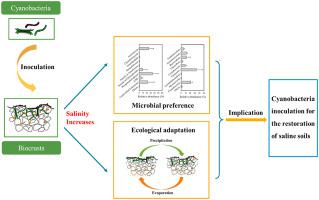Soil Biology and Biochemistry ( IF 9.8 ) Pub Date : 2022-04-30 , DOI: 10.1016/j.soilbio.2022.108691 Li Wu 1, 2 , María E. Farías 3 , Rosa M. Torres 4 , Ling Xia 1 , Shaoxian Song 1 , Abdullah A. Saber 5 , Shubin Lan 2

|
Cyanobacterial inoculation is a promising technology that can induce biocrust development, for stabilizing degraded soils in dryland environments. However, it is challenging to grow cyanobacteria in dry, saline soils, which limits the application of this technology. In this study, NaCl was added into field-collected induced biocrusts to investigate how salt affects the biocrust community. This fundamental knowledge improves our assessment of microbial salinity preference and adaptation, and can guide researchers to select the appropriate cyanobacterial inoculants for saline soil restoration. The results showed that the biocrusts induced by inoculating Microcoleus vaginatus and Scytonema javanicum could survive 1.0% salinity, although both salt and drought stresses significantly inhibited microbial biomass and metabolism (P < 0.05), and salinity led to an obvious shift in microbial community structure. Compared to salt stress, drought seems to provide a vital ecological protection for the biocrusts, allowing them to be active only under relative low salinity after hydration. In the induced biocrusts, cyanobacteria were always the dominant organisms (even 18 years since inoculation), whereas under elevated salinity, cyanobacterial communities with lower relative abundance had a higher survival percentage of M. steenstrupii and Phormidium sp. Altogether, our results showed that both prokaryotic and eukaryotic communities have obvious salinity preference in the cyanobacteria-induced biocrusts. These results suggest that cyanobacterial inoculation strategies can be adapted in response to the soil salinity conditions. Furthermore, a combined inoculation of M. steenstrupii and Phormidium sp. appears to be favorable approach that is expected to improve cyanobacterial inoculation technology in saline soils.
中文翻译:

盐度影响人工诱导的生物结皮中的微生物组成和功能:对盐渍土壤中蓝藻接种的意义
蓝藻接种是一种很有前途的技术,可以诱导生物结皮发育,用于稳定旱地环境中的退化土壤。然而,在干燥的盐渍土壤中培养蓝藻具有挑战性,这限制了该技术的应用。在这项研究中,将 NaCl 添加到现场收集的诱导生物结皮中,以研究盐如何影响生物结皮群落。这一基础知识提高了我们对微生物盐分偏好和适应性的评估,并可以指导研究人员选择合适的蓝藻接种剂来恢复盐渍土。结果表明,接种Microcoleus vaginatus和Scytonema javanicum诱导的生物结皮盐胁迫和干旱胁迫均显着抑制微生物生物量和代谢(P < 0.05),盐分导致微生物群落结构发生明显变化。与盐胁迫相比,干旱似乎为生物结皮提供了重要的生态保护,使它们只有在水化后相对低盐度的情况下才能活跃。在诱导的生物结皮中,蓝藻始终是优势生物(甚至在接种后 18 年),而在盐度升高的情况下,相对丰度较低的蓝藻群落的M. steenstrupii和Phormidium的存活率较高sp。总之,我们的研究结果表明,原核生物和真核生物群落在蓝藻诱导的生物结皮中都具有明显的盐度偏好。这些结果表明,蓝藻接种策略可以适应土壤盐分条件。此外,M. steenstrupii和Phormidium sp. 的联合接种。似乎是一种有利的方法,有望改善盐渍土壤中的蓝藻接种技术。











































 京公网安备 11010802027423号
京公网安备 11010802027423号